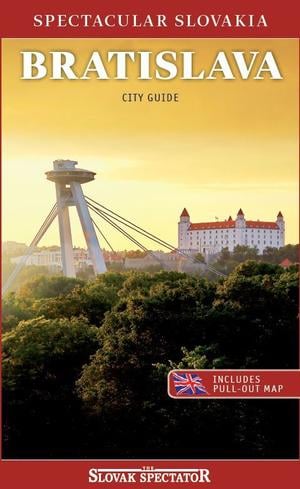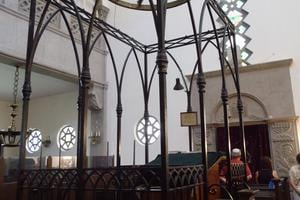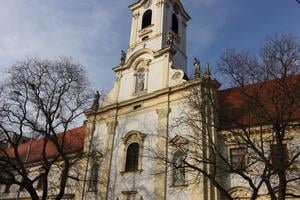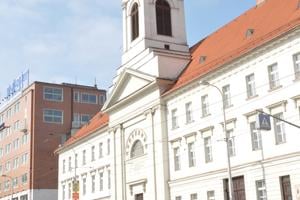You have access to this premium content thanks to ING Hubs Slovakia, the expert hub of global banking.
This article was published in the latest edition of our Bratislava City Guide, which can be obtained from our online shop with Spectacular Slovakia travel guides.
For some contemporary visitors, Bratislava is merely Party-Slava, home of nightclubs and bars. But that view of the city is only a modern one: for hundreds of years the dominant presence here has been religion, and Bratislava remains a wonderful place in which to sit in the cool shadows of ancient walls and statues of saints, or to contemplate in silence while basking in the sunlight reflected through the majestic coloured windows of its spectacular places of worship.

Since as long as records go back, Bratislava has been the destination for pilgrims who have come to engage with the city’s rich spiritual history. There are five sites in Bratislava that are of particular relevance and to which pilgrims continue to come to pay homage.
JOHN THE ALMONER
One of the first places most tourists will visit in Bratislava is St Martin’s Cathedral, one of the greatest monuments of the city and significant as the coronation church of the Hungarian Kingdom. It is also a specific pilgrimage destination. In the Chapel of St John the Almoner (Kaplnka sv. Jána Almužníka) on the left side of the church, are the mortal remains of John the Merciful.
John was the patriarch of Alexandria, born in Cyprus in the seventh century. His body took a circuitous route to Slovakia, via Istanbul (which was then Constantinople) and Venice, before arriving in Slovakia, probably in the mid 16th century. His remains are now stored in a glazed silver shrine above the altar in the chapel that bears his name.
Sunday services in foreign languages
ROMAN CATHOLIC CHURCH
St Martin’s Cathedral: 9:00 (Latin) (www.dom.fara.sk)
Church of St Ladislaus: 11.00 (ENG)
OTHER CHRISTIAN CHURCHES
Malý evanjelický kostol (Small Evangelical Church): Panenská Street (entrance from Lýcejná Street), 9:00 (GER), 10:00 (ENG) (www.bratislavainternationalchurch.or)
Citylight Church: Nám. 1.mája 1, 10:00 (ENG); ; (www.citylightbratislava.com)
Bratislava International Fellowship: Sreznevského 2, 10:00 (ENG), (www.bif.sk)
International Baptist Church: Súľovská 2; 10:15 (ENG), (www.ibcb.baptist.sk)
JEWISH SERVICE
Jewish Synagogue: Friday evening (before twilight), Saturday morning (usually at 9:00), and during feasts. Services held in Hebrew. During winter services in building of Židovská náboženská obec at Kozia Street. (www.synagogue.sk)
CHATAM SOFER
Bratislava has also always been an important centre of Jewish culture, despite suffering long periods of persecution common across Europe, as well as a series of construction projects that have devastated former Jewish neighbourhoods. Nevertheless, one crucial site in the city has remained intact and is now visited by Jews from across the world.
The old Jewish cemetery, at the bottom of the castle hill, dates from the 17th century and at one time contained around 6,000 graves. Much of it was destroyed in 1942-43 when a tram tunnel was built under the castle, exiting through the cemetery. Latterly, the rest of the former Jewish quarter was razed during construction of the SNP Bridge in 1969.
However, one of the tombs that was saved and is now preserved in a tiny underground room is the final resting place of Chatam Sofer, the orthodox scholar born Moshe Schreiber in 1762 and who died in 1839. Sofer became Chief Rabbi of Pressburg in 1806 and also headed the yeshiva (rabbinical school) in the city. He was a strictly Orthodox rabbi. Somehow his tomb was saved despite the massive societal upheavals and the scarring of the landscape. Most visitors now come in September, on the anniversary of his death, to pay their respects.
“This town was always tolerant,” said Viera Kamenická, from the Museum of Jewish Culture in Bratislava, part of the Slovak National Museum.
CALVARY
There was once also a Calvary in the hills of Bratislava, close to the Church of Our Lady of the Snows. But 13 of its 14 stops were destroyed during the previous regime, as well as the tower of the church, leaving only the peaceful Lourdes cave. It contains a statue of the Virgin Mary, surrounded by hundreds of marble plaques offering thanks. Although plans for redevelopment of the whole Calvary are often discussed, priorities tend to be with the reconstruction of existing monuments rather than building from new, and there are no fixed dates for the construction.
REPRESSIONS
Pilgrimage sites
Jewish Cemetery: www.jewishcemetery.sk
Lourdes cave: Pod Kalváriou; The cave is located close to the Church of Our Lady of the Snows an approximate 20-minute walk along Hlboká Street from the bus stop Pod stanicou
Church of the Holy Cross (Kostol povýšenia Sv. Kríža): Biskupická 64, Bratislava (mortal remains of Sister Zdenka)
Calvary: path starts at Za sokolovňou street and leads through the forest; FB: bratislavskakalvaria
Church of Our Lady of Seven Sorrows (Kostol Sedembolestnej Panny Márie): Osloboditeľská 27, Bratislava- Vajnory (mortal remains of Titus Zeman)
Marianka (Marian Valley): to visit the pilgrimage site - follow the street Námestie 4. apríla and descend to located The Marian Way and The Way of the Cross sacred journey featured by many landmarks as The Church of the Nativity of the Virgin Mary
The cruelties of the communist regime are evidenced in the story of the first beatified woman in Slovakia. Sister Zdenka, civilian name Cecilia Scheling, assisted in 1952 several Catholic priests escaping from former Czechoslovakia. The communist secret police imprisoned and tortured her on the grounds of treason. She was released in 1955 but died just months later. Pope John Paul II beatified Sister Zdenka as a martyr during a 2003 visit to Slovakia.
“There were worshippers from the Philippines and Vietnam who were curious about her,” said Mária Terézia, a nun from the congregation of the Sisters of Mercy of the Holy Cross.
The mortal remains of Sister Zdenka are placed in the Church of Holy Cross in the eastern part of Bratislava, where pilgrims go to pray.
Another blessed martyr from the communist era is the Slovak Salesian priest Titus Zeman. His mortal remains are placed in the Church of our Lady of Seven Sorrows in the north part of the city.
MARIAN VALLEY
Another of the most visited and most important pilgrimage sites in Slovakia is the Marian Valley and the village of Marianka, the oldest Catholic pilgrimage destination in Slovakia and one of the oldest in the whole of central Europe. As the name suggests, the whole area is devoted to the Virgin Mary and includes numerous holy sites, drawing pilgrims from across the region for several centuries.
The most significant sites are the Pilgrimage Church of the Nativity of Virgin Mary (Kostol Narodenia Panny Márie), a shrine to the Virgin Mary that has come to be known as the Lourdes cave, the Chapel of the Holy Well, and the Way of the Cross, which has 14 stopping points.
Many legends have grown up concerning the healing powers of a visit to the area, and to be gained from praying to a statue of the Virgin Mary believed to date from 1030. In 2011, the Marian Valley also gained the privileges of a basilica minor, which means visitors can obtain indulgence here. The Marian Valley is visited by 200–300 pilgrims on the first Saturday of every month, increasing to 500– 1,000 during good weather. Regardless of the conditions, the Feast of the Holy Trinity, in spring (May or June), and the Feast of Nativity of Our Lady, in September, usually attract 5,000–6,000 pilgrims annually.
Author: Bratislava City Guide



